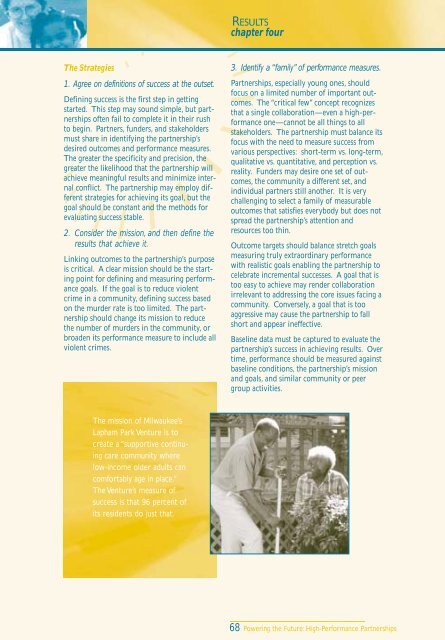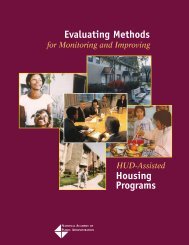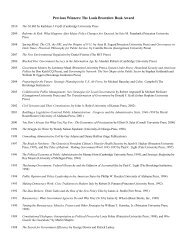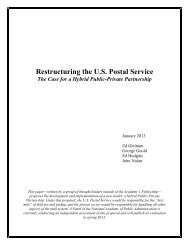High-Performance Partnerships - National Academy of Public ...
High-Performance Partnerships - National Academy of Public ...
High-Performance Partnerships - National Academy of Public ...
Create successful ePaper yourself
Turn your PDF publications into a flip-book with our unique Google optimized e-Paper software.
RESULTS<br />
chapter four<br />
The Strategies<br />
1. Agree on definitions <strong>of</strong> success at the outset.<br />
Defining success is the first step in getting<br />
started. This step may sound simple, but partnerships<br />
<strong>of</strong>ten fail to complete it in their rush<br />
to begin. Partners, funders, and stakeholders<br />
must share in identifying the partnership’s<br />
desired outcomes and performance measures.<br />
The greater the specificity and precision, the<br />
greater the likelihood that the partnership will<br />
achieve meaningful results and minimize internal<br />
conflict. The partnership may employ different<br />
strategies for achieving its goal, but the<br />
goal should be constant and the methods for<br />
evaluating success stable.<br />
2. Consider the mission, and then define the<br />
results that achieve it.<br />
Linking outcomes to the partnership’s purpose<br />
is critical. A clear mission should be the starting<br />
point for defining and measuring performance<br />
goals. If the goal is to reduce violent<br />
crime in a community, defining success based<br />
on the murder rate is too limited. The partnership<br />
should change its mission to reduce<br />
the number <strong>of</strong> murders in the community, or<br />
broaden its performance measure to include all<br />
violent crimes.<br />
3. Identify a “family” <strong>of</strong> performance measures.<br />
<strong>Partnerships</strong>, especially young ones, should<br />
focus on a limited number <strong>of</strong> important outcomes.<br />
The “critical few” concept recognizes<br />
that a single collaboration—even a high-performance<br />
one—cannot be all things to all<br />
stakeholders. The partnership must balance its<br />
focus with the need to measure success from<br />
various perspectives: short-term vs. long-term,<br />
qualitative vs. quantitative, and perception vs.<br />
reality. Funders may desire one set <strong>of</strong> outcomes,<br />
the community a different set, and<br />
individual partners still another. It is very<br />
challenging to select a family <strong>of</strong> measurable<br />
outcomes that satisfies everybody but does not<br />
spread the partnership’s attention and<br />
resources too thin.<br />
Outcome targets should balance stretch goals<br />
measuring truly extraordinary performance<br />
with realistic goals enabling the partnership to<br />
celebrate incremental successes. A goal that is<br />
too easy to achieve may render collaboration<br />
irrelevant to addressing the core issues facing a<br />
community. Conversely, a goal that is too<br />
aggressive may cause the partnership to fall<br />
short and appear ineffective.<br />
Baseline data must be captured to evaluate the<br />
partnership’s success in achieving results. Over<br />
time, performance should be measured against<br />
baseline conditions, the partnership’s mission<br />
and goals, and similar community or peer<br />
group activities.<br />
The mission <strong>of</strong> Milwaukee’s<br />
Lapham Park Venture is to<br />
create a “supportive continuing<br />
care community where<br />
low-income older adults can<br />
comfortably age in place.”<br />
The Venture’s measure <strong>of</strong><br />
success is that 96 percent <strong>of</strong><br />
its residents do just that.<br />
68 Powering the Future: <strong>High</strong>-<strong>Performance</strong> <strong>Partnerships</strong>









